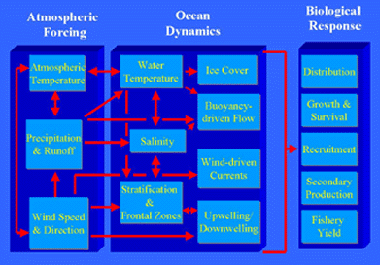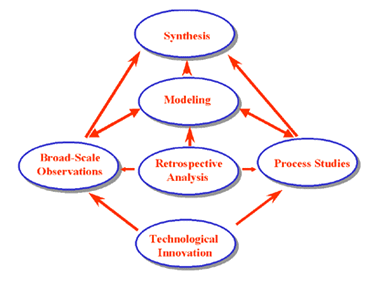|
|
U.S. GLOBEC (GLOBal Ocean ECosystems Dynamics) is a multi-disciplinary research program designed by oceanographers, fishery scientists, and marine ecologists to examine the potential impact of global climate change on ocean ecosystems. U.S. GLOBEC is a component of the U.S. Global Change Research Program and is linked to worldwide research on this topic through the International GLOBEC Program ....
The objective of U.S. GLOBEC research is to understand how climate change and variability will translate into changes in the structure and dynamics of marine ecosystems and in fishery production.
Fishing is a $40 billion per year industry in the United States, and understanding the joint impact of climate and harvesting on marine populations and communities is essential for the development of sustainable fishery management practices ....
Global climate change models consistently predict increases in atmospheric temperature and changes in wind patterns and precipitation. The anticipated changes are greatest at higher latitudes. These changes can be expected to have several direct consequences for the oceans and for marine life. Increased air temperatures will result in increases in water temperatures and increased melting of sea ice in the polar regions. Increases in rainfall will result in increases in freshwater runoff into the sea with resulting impacts on salinity. As the temperature difference between the tropics and the higher latitude regions decreases, we can expect reduced strength in the trade-winds and other important wind fields ....
Collectively, these changes in temperature, salinity, and winds will have important effects on ocean currents and other oceanic structures such as frontal zones and upwelling regions. Marine species depend on ocean currents for dispersal, and on frontal zones and other features as concentrating mechanisms and feeding locations. Upwelling regions are highly productive areas where nutrient-rich bottom water is brought to the surface and supports the growth of microscopic plants (phytoplankton) at the base of the food web ....
 Interactive pathways between atmospheric forcing mechanisms, ocean response to these forcing factors, and the biological factors affected .... |
The predicted changes in the oceans include a potential weakening of wind-driven currents such as the Gulf Stream, an intensification of currents dominated by the effects of freshwater inputs (e.g. the Alaska Coastal Current and the Labrador Current) and a strengthening of the layering (or stratification) of coastal waters due to differences in seawater density with depth. Reduction in wind strength could result in a reduction in upwelling in some areas depending on local wind and temperature conditions on land. Increases in the intensity and frequency of El Niño events are predicted in some climate models ....
U.S. GLOBEC studies have begun in several locations where the effects on marine populations and ecosystems of changes in currents, circulation patterns, upwelling and downwelling, stability of the water column, or sea ice can be examined in detail. Research sites have been specifically chosen to afford opportunities to study one or more of these processes and their effects on selected species ....
To study these processes and systems, U.S.GLOBEC researchers are developing and applying computer models of the physics and biology of the seas, conducting studies of key processes to be included in these models, undertaking large-scale observational programs using advanced observational systems, and extracting new information from long-standing programs and data sets. This inter-related sequence of modeling, process-oriented studies, broad scale observations, and retrospective studies is a key element of the GLOBEC research strategy. These program elements provide essential pieces of information on a broad spectrum of spatial and temporal scales. The various components of the program will then integrated in synthesis programs within regional study areas and among sites ....
 |
U.S. GLOBEC data are available at an allied website (the GLOBEC Data Hub at WHOI) in standardized format through a distributed data management system ....
 Overview
Overview


